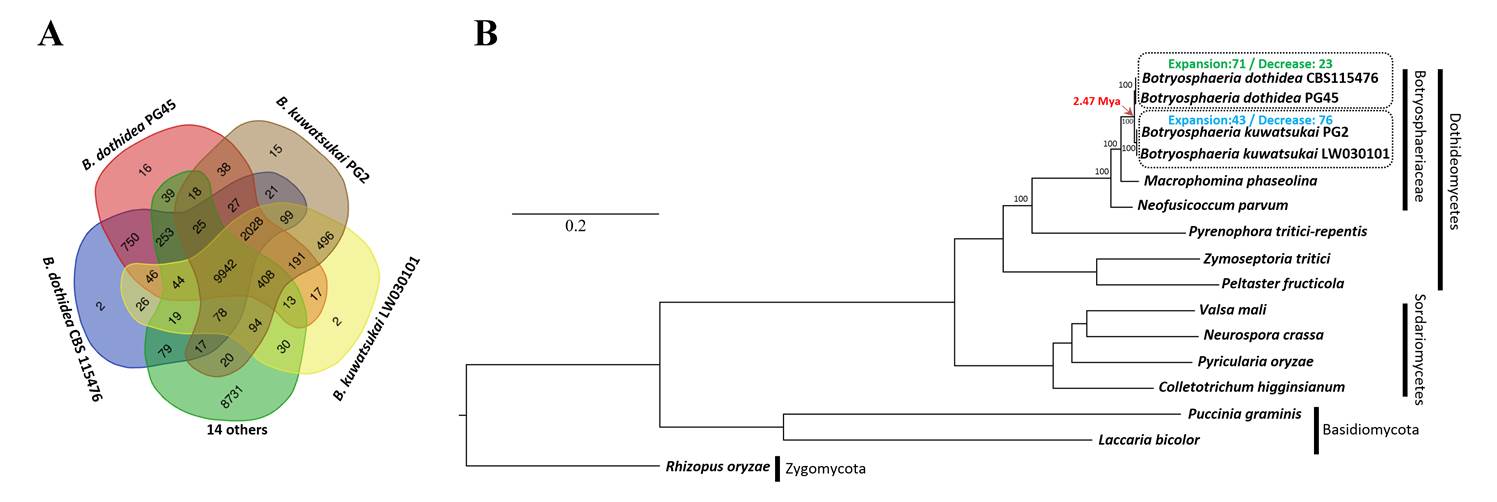Comparative genomics of Botryosphaeria dothidea and B. kuwatsukai, causal agents of apple ring rot, reveals both species expansion of pathogenicity-related genes and variations in virulence gene content during speciation
作者: 來源:科研辦 發(fā)布日期:2018-09-19 瀏覽次數(shù):
論文信息:Bo Wang , Xiaofei Liang, Mark L. Gleason, Rong Zhang, and Guangyu Sun. Comparative genomics of Botryosphaeria dothidea and B. kuwatsukai, causal agents of apple ring rot, reveals both species expansion of pathogenicity-related genes and variations in virulence gene content during speciation. IMA Fungus, 2018, 9(2): 243-257.
JCR分區(qū)Q2,,IF=4.308
蘋果輪紋病是一種世界性病害,,病害分布廣,,在亞洲,、美洲、歐洲,、澳洲,、非洲等地均有發(fā)生,。中國主要蘋果產(chǎn)區(qū)均有發(fā)生,高溫多雨的東部地區(qū)嚴重時可造成50%-60%爛果率,,給我國蘋果產(chǎn)業(yè)經(jīng)濟帶來巨大損失,。前期研究發(fā)現(xiàn),蘋果輪紋病由兩種不同病原,,葡萄座腔菌(Botryosphaeria dothidea)和粗皮葡萄座腔菌(B. kuwatsukai.)引起,。兩種病原菌在系統(tǒng)演化、致病性,、寄主范圍、生物特性等方面都存在顯著差異(Fungal Diversity:2015),,但造成這些差異的機理尚不清楚,。該研究通過比較基因組分析發(fā)現(xiàn),,兩種病原菌大約在247萬年前分化成不同種類;與葡萄座腔菌科其他種類相比,,兩病原菌的致病菌基因數(shù)量遠超過同科的其他種,,說明它們可能經(jīng)歷了第二輪基因組支系擴張;發(fā)現(xiàn)葡萄座腔菌基因組中,,與植物侵染互作所相關(guān)細胞壁降解酶,、次級代謝合成相關(guān)基因、分泌型肽酶等,,明顯多于粗皮葡萄座腔菌,,這可能是葡萄座腔菌寄主范圍廣、致病性強的重要原因,。該研究全面的解析了兩病原菌進化方向,、物種形成及致病性差異可能機制,為進一步研究該類真菌與寄主互作,、育種,、防治策略制定提供了指引。

葡萄座腔菌和粗皮葡萄座腔菌同源性與系統(tǒng)基因組關(guān)系
論文摘要:Ring rot, one of the most destructive diseases of apple worldwide, is caused primarily by Botryosphaeria dothidea and B. kuwatsukai. Here, we sequenced the genomes of B. dothidea strain PG45 (44.3 Mb with 5.12 % repeat rate) and B. kuwatsukai epitype strain PG2 (48.0 Mb with 13.02 % repeat rate), and conducted a comparative analysis of these two genomes, as well as other sequenced fungal genomes, in order to understand speciation and distinctive patterns of evolution of pathogenicity-related genes. Pair-wise genome alignments revealed that the two species are highly syntenic (96.74 % average sequence identity). Both species encode a significant number of pathogenicity-related genes, e.g. carbohydrate active enzymes (CAZYs), plant cell wall degrading enzymes (PCWDEs), secondary metabolites (SMs) biosynthetic enzymes, cytochrome P450 enzymes (CYPs), and secreted peptidases, in comparison to all additional sequenced fungal species involved in various life-styles. The number of pathogenicity-related genes in B. dothidea and B. kuwatsukai is higher than other genomes of Botryosphaeriaceae pathogens (Macrophomina phaseolina and Neofusicoccum parvum), suggesting a secondary round of Botryosphaeria-lineage expansion in the family. There were, however, also significant differences in the genomes of the two Botryosphaeria species. Botryosphaeria kuwatsukai, which infects only apple and pear, apparently lost a set of SMs genes, CAZYs and PCWDEs, possibly as a result of host specialization. Botryosphaeria kuwatsukai contained significantly more transposable elements and higher value of repeat induced point (RIP) index than B. dothidea. Our results will be instrumental in understanding how both phytopathogens interact with their plant hosts and in designing efficient strategies for disease control and molecular breeding to help ensure global apple production and food security.
編輯:0
終審:0


